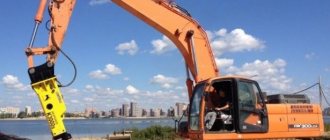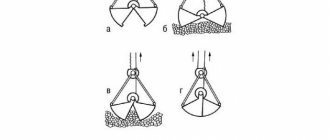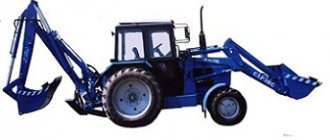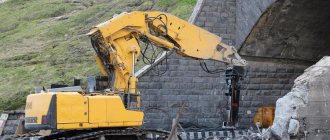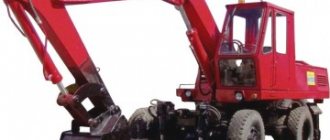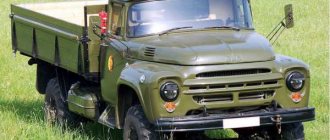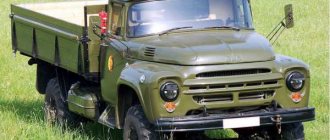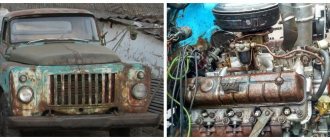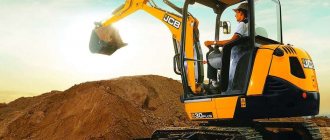A little history
A hydraulic hammer is an additional attachment for excavators, which performs impact actions using the hydraulic system of special equipment. Most often, hydraulic hammers are equipped with different replaceable attachments for different jobs. The operating principle is reminiscent of a pneumatic jackhammer, which was previously used by road workers to carry out repair work.
The hydraulic hammer, as an additional attachment, began to be used back in Soviet times. The first hydraulic hammers did not have very high power, but this did not become an obstacle to their development. This equipment was actively used for the reason that it did not require an additional unit of equipment. Even a conventional pneumatic jackhammer required a huge compressor and a separate person to operate it. But the hydraulic hammer could be installed on an excavator, which was already present in most construction or repair work.
Every year, hydraulic hammers have been actively developing and improving. They began to have higher impact force and more compact sizes. If the first hydraulic hammers took hours to install on an excavator, modern ones can be installed in a few minutes. Nowadays they have many areas of application.
This is interesting: Photo MTZ-80 Belarus: box and cabin
Classification of hydraulic hammers
- Small hydraulic hammers have an impact energy of up to 1500 J. Such equipment is installed exclusively on the smallest excavators, which can work not only outdoors, but also indoors.
- Medium hydraulic hammers are the most popular. They are installed on most large excavators. The impact force ranges from 1500 to 3500 J. They are used on almost all construction sites and during road work. In addition, most dismantling work is carried out using medium-sized hydraulic hammers.
- Heavy (large) hydraulic hammers are the largest and most powerful equipment that have an impact energy of more than 3500 J. Such hydraulic hammers, in most cases, are installed on crawler excavators. This technique is used in quarries for the extraction of solid minerals and in the construction of tunnels and new metro lines.
Design and principle of operation
The hydraulic hammer includes the following components:
- work item;
- upper, lower and guide bushings;
- finger and grease fitting;
- lower body (axlebox);
- the cylinder itself and its cover;
- breather;
- hydraulic distributor;
- firing pin (piston);
- seal block;
- filling device;
- cylinder cover;
- coupling bolts (studs).
The internal structure of a hydraulic impact tool can be symbolically divided into 3 basic working units.
- Impact tool (pike) - the configuration depends on the purpose, it can be in the form of a wedge (chisel), rammer, spatula, pencil and cone.
- Piston unit - through fluid pressure, a piston is launched, which, moving, transfers energy to the impact tool.
- Pneumatic chamber - softens the reverse stroke of the piston, equipped with a valve to regulate the amount of gas and pressure.
Hydraulic hammer operation
So, to operate from a hydraulic system, a hydraulic hammer is connected to an excavator or loader. When the hammer is at the bottom of the hammer, the valve opens and the hydraulic pump pumps oil into the cylinder. The oil pressure is greater than the pressure in the nitrogen chamber, so the piston rises, compressing the nitrogen.
When the firing pin reaches the highest point, the spool closes the valve through which oil flows. Instead, the drain valve opens. The oil leaves the cylinder into the hydraulic system line, and the piston, under nitrogen pressure, tends downward, striking the working tool.
Some models of hydraulic hammers use hydraulic accumulators instead of a nitrogen chamber. But now they are becoming less and less common, because... A nitrogen hydraulic hammer will last much longer and will be cheaper to maintain than a battery-powered one.
In addition, modern hydraulic hammers are designed in such a way that oil can push the hammer upward only if it is slightly raised above the lowest point. You can lift the piston by resting the lance against the ground or material that needs to be destroyed. Thus, the hydraulic hammer does not make idle blows. Due to this, its service life increases.
Options
The equipment is produced by domestic and Western companies, and is therefore suitable for almost all models of earthmoving equipment. We have already mentioned that the optimal solution would be a crawler excavator with a hydraulic hammer. This technique is more stable when performing work.
In addition, tracked vehicles have the ability to install a counterweight. In addition, the tracked equipment has a full platform rotation, which ensures work in confined spaces.
The technical characteristics of the hydraulic hammer can be considered using the example of the domestic model MG-300. This unit is manufactured.
| Equipment length | 2,500 mm |
| Weight | 950 kg |
| Excavator structural weight min/max | 12,000/25,000 kg |
| Impact force | 3,000 J |
| Beat frequency per unit time | 270 beats/min |
| Fluid pressure in the hydraulic system | 16 MPa |
| Pressure in the pneumatic system | 0.8 MPa |
| Hydraulic fluid flow | 110-220 l/min |
This excavator-based hydraulic hammer has a number of undeniable advantages:
- Air intake and exhaust are carried out outside the working chamber. This scheme provides a large resource of work.
- Bronze liners are replaced with wear-resistant seals.
- The housing design allows for quick replacement of the lance.
- The equipment can operate at sub-zero temperatures.
- Great repairability and no problems with spare parts.
Among the shortcomings, one can note a violation of the housing geometry due to mechanical damage. In addition, rubber seals wear out quickly, which leads to unplanned losses of working fluid in the system.
Equipment maintenance is carried out daily by the excavator operator. At the same time, contaminants are removed and the working units of the hydraulic hammer are lubricated.
Features of the equipment and its installation
This equipment is intended primarily for tracked vehicles. It can also be installed on wheeled models, but a significant disadvantage is the fact that they do not have sufficient stability. Installing hydraulic hammers, like any other attachment, is a simple process that an excavator operator can handle independently, without the help of specialists. When choosing this element, you should pay attention to its power and weight. It is important that the mass of the product does not exceed ten percent of the total weight of the machine - only then can it be avoided from tilting. The model is also selected depending on the complexity of the tasks assigned to the equipment and the type of soil.
The hammer itself consists of three working blocks:
- impact element, the shape of which depends on the purpose of use;
- piston unit;
- nitrogen chamber.
The liquid, under pressure set by the hydraulic distributor, transmits an impulse to the striker (piston). Moving up and down, the piston hits the working tool and transfers energy to it. It is possible to operate the hydraulic hammer in automatic mode, subject to the additional installation of a pneumatic distributor valve. The power of the blow depends on the size of the portion of energy received. The faster the striker moves, the more often the ground is struck. The choice of tip also depends on the type of work performed. So, you can install a tamper, a shovel or a wedge.
Hydraulic hammers with individual adapters from the group
Therefore, suppliers who monitor the quality of the products supplied do not offer their customers universal pendants. Of course, universal adapters eliminate the need for suppliers to maintain additional warehouse and production space. However, the reputation of the seller and the nerves of the customer are more expensive. In addition, adapters for almost all domestic and foreign models of excavators and hydraulic hammers have already been developed, so their delivery does not affect the order lead time.
The group supplies hydraulic hammers from the Korean company ICM. The delivery package already includes an adapter made for a specific model of excavator or mini-loader. It is included in the price of the hydraulic hammer. If necessary, we manufacture the adapter individually according to the customer’s dimensions. Therefore, when buying a hydraulic hammer from us, you get a reliable and durable design, as well as all the additional services for its maintenance.
Main applications of hydraulic hammers
- Dismantling work is the most popular area of application. You can dismantle old foundations, walls, floor elements and other concrete elements.
- Men at work . A hydraulic hammer is used for any road repair. Such equipment can not only dismantle old asphalt, but also clean up after itself and load it all onto a dump truck.
- Construction works . Most people think that a hydraulic hammer can only dismantle. But that's not true. He also helps in construction. They are often used to drive piles into the ground. In addition, they are also used for splitting pile blocks and other elements.
- Excavation . Very often in winter, before the start of any excavation work. With their help, the frozen layer of soil is removed.
- Works with hard rocks . Powerful excavators equipped with hydraulic hammers work in quarries and use them to build tunnels in hard rock.
These are just the main areas of application for hydraulic hammers. In addition to them, there are many additional ones. Modern hydraulic hammers come in different sizes and power ratings. But they are usually classified according to the force of impact.
This is interesting: Fittings GOST 52544-2006 - technical characteristics
Scope of application of an excavator-based hydraulic hammer
An excavator-based hydraulic hammer is a very convenient and useful technique with which you can perform many heavy types of construction work, most of them dismantling, such as:
- Excavation of problem areas - rocky, frozen or hard soils.
- Dismantling road surfaces made of asphalt, concrete or slabs, removing curbs.
- Elimination of old buildings and structures unsuitable for use, including destruction of foundations.
- Dismantling through breaking up unnecessary structures - monolithic and reinforced concrete.
- Excavation of rocks and quarries.
Excavator-based hydraulic hammer
The hydraulic hammer can also be used for installation, such as:
- Compacting soils for construction.
- Deepening piles when preparing the foundation.
A hammer is an impact-type attachment, the installation of which is available not only on heavy excavators, but also on tractors and loaders. Using a hammer, you can prepare the ground for bucket manipulation, laying communications, demolishing unnecessary structures, and clearing the territory. Without this impact tool, construction in winter would be impossible, since laying a foundation in frozen soil using only a bucket on an excavator is an impossible task.
What is a hydraulic hammer
A hydraulic hammer is a device that helps to bury pile elements into the ground or process high-strength material . The main advantage of such equipment is the possibility of its use as a mounted auxiliary unit.
The diesel engine and modern pneumatic and hydraulic equipment allow you to use the hydraulic hammer with greater efficiency and complete amazing construction projects in the shortest possible time.
Typically, the hydraulic hammer is installed on medium-sized wheeled tractors. The principle of its installation is an additional hitch, the operation of which is ensured by the hydraulics of the self-propelled machine and its powerful diesel unit, capable of providing the required level of performance.
Diagram of a hydraulic hammer.
It looks like this:
- The housing, inside of which the hydraulic rotator is installed,
- The distributor located next to the striker
- Percussion instrument.
- Nitrogen chamber designed to dampen the reverse stroke of the striker.
The distributor applies pressure to the fluid needed to fire the firing pin. When it starts to move, kinetic energy sets the percussion instrument in motion.
The hydraulic hammer has various types of peaks: ramming; shoulder blade; wedge-shaped tip. The peaks are removable and can be changed. on the hydraulic hammer . Thanks to this, the hydraulic hammer operates automatically, without the use of a compressor unit.
Technical parameters of the hydraulic hammer
The range of excavator-based hydraulic hammers is huge. They differ from each other in technical characteristics that affect their suitability for carrying out certain work, productivity and quality of execution.
Main characteristics:
- The weight of the equipment and the machine on which it can be used is a hammer from 97 to 7100 kg, and transport - from 1 to 120 tons.
- Working pressure – from 80 bar (8 MPa) to 210 bar (21 MPa).
- Length (height) – from 1 to 5 meters.
- Beat frequency – from 250–400 to 600–1200 beats per minute.
- Impact energy – from 400 to 16740 J.
- Oil consumption – from 20–30 to 360–450 liters per minute.
- Diameter / length of the lance – from 46 to 210 mm / from 30 to 1011 mm.
Technical characteristics of hydraulic hammers
An excavator with a hydraulic hammer can be tracked or wheeled.
Among the advantages of wheeled equipment, the main one is its mobility - delivery of equipment to an object of any remoteness is not difficult. Otherwise, the delivery of the tool is carried out by means of a trawl. The disadvantage is instability.
Tracked special equipment is more stable, which means it can be used as a basis for a heavier hammer. And thanks to the rotating platform, it can work even in cramped conditions. The disadvantage is the difficulty of transportation to a new facility.
How does a hydraulic hammer work?
To operate a hydraulic hammer, it must be connected to the hydraulic system of the loader . After the connection has occurred, oil begins to be pumped into the cavity of the hydraulic impact tool through a specialized valve. The hydraulic pump is responsible for the quality and intensity of oil injection.
Under the force of pressure generated by the oil flow, the piston (driver) of the hydraulic pump begins to move, initiating the compression of nitrogen in the pneumatic chamber. When the striker rises, the valve opens the oil drain line and shuts off the discharge line.
The compressed nitrogen acts on the striker and initiates its lowering. The oil is thrown into the return line and the lance is hit.
Oil can only lift the firing pin when it is in a raised position. Most hydraulic impact tools have a similar design. The striker tends to rise when it comes into contact with an object that needs to be broken. With this structure of the mechanism, the possibility of idle impacts, which quickly trigger the parts of the hydraulic hammer, is eliminated.
It follows that the operating principle of a hydraulic impact tool is based on a 3-phase movement:
- acceleration phase in the upward direction;
- braking phase until reaching top dead center (TDC);
- acceleration phase before impact.
In the cylinders of a hydraulic hammer, the volume of liquid is a variable quantity. Hydraulic pumps provide a stable supply of working fluid. To increase the efficiency of the unit, auxiliary hydraulic accumulators are installed in the body of hydraulic impact tools. They accumulate liquid during operation and return it when the piston speed increases.
How to choose a hydraulic hammer
In order for a mini-excavator to work with a hammer, drill or hydraulic rotator in uninterrupted mode, you need to select the right equipment.
The principles of such purchase of attachments include:
- Compatibility of the hammer with the hydraulic system of the unit.
- Compatibility of technical parameters.
- The flow rate of working fluid, which must correspond to the performance of the hydraulic pump installed on the excavator.
- Type of work performed.
- The operating pressure level of the hammer, which should be at the same level as the pressure of the excavator. It is unacceptable for this figure to be less, as this causes rapid wear of the hammer.
- Some models do not have a pump power regulator, but then you need to find a safety valve on the pressure supply line. Its functions are to limit the pressure level and prevent emergency situations from occurring.
It is also necessary to take into account the density of the material with which the equipment will have to work. If the hammer receives enough energy to operate, it can easily destroy monoliths and pierce concrete and road surfaces. A hydraulic hammer, which needs to destroy not very massive structures, can receive a small amount of kinetic energy. But at the same time, the frequency of impacts should be quite high.
If these rules are not followed, there will be disturbances in the pressure and operation of the forklift, equipment and internal systems.
Model GPM-120
GPM-120 is one of the many types of attachments for an excavator. This model is perfect for excavators and their modifications.
The GPM-120 hydraulic hammer is used in many areas. This is possible thanks to the availability of different types of interchangeable tools, such as wedges, peaks or tampers , widely used for repairs, tunnel construction, as well as various dismantling works.
The tool makes it possible to destroy various types of structures, and the material and dimensions of the object are not of fundamental importance. Opening up old road surfaces or compacting soil is also much easier and faster using a hydraulic hammer.
Features of application
The first development was carried out back in Soviet times. When inventing the hydraulic hammer, the geographical features of the area were taken into account.
The modern GPM-120 was developed using new technology based on Soviet technology, which made it possible to implement an easy-to-use and fairly effective tool. It differs in that the oil is distributed by the striker itself, and there is no additional need to use a hydraulic distributor to reverse the piston - striker.
Distinctive features
The hydraulic hammer-120 is easy to operate, its repair and maintenance do not cause any particular difficulties. The temperature range of its use is from - 400 C to + 400 C. It is easy to mount on an excavator or loader, while the handle is removed and the hydraulic hammer itself is installed on the boom .
You can only use the GPM-120 hitch, mounting it on the handle instead of the bucket. The new modern tool has far surpassed the old Soviet model both in its reliability and in its simplicity and ease of use.
Application of various nozzles
GPM-120 nozzles come in different types:
- The peak is the best option for crushing and opening concrete coatings;
- Wedge – designed for loosening asphalt surfaces or frozen soil;
- Tamping - used to compact areas of land with loose soil.
This universal device combines three tools necessary for construction. This contributes to good maneuverability of the machine and its economical use.
Hydraulic hammer attachments
Since medium hydraulic hammers are the most popular, almost all of them are equipped with a standard set of attachments: a peak, a wedge, a chisel, a tamper and a pile cap.
Let's take a closer look at each attachment:
- The peak is the most popular attachment, which has a cylindrical shape, but is sharpened not on two sides like a chisel, but on four. With the help of a lance, you can crush absolutely all solid objects. The lance is used for crushing, not for directional splitting.
- A wedge is a cylindrical replaceable attachment that is sharpened on both sides. A wedge is used to crush and split most hard objects. This can be frozen soil, concrete objects, asphalt and asphalt concrete road surfaces. In addition, most hard rocks can be split using a wedge. The difference between a wedge and a chisel is that it has a sharpening of no more than 30 degrees.
- A chisel is an attachment that is practically no different from a wedge. It has the only difference – the sharpening angle is more than 30 degrees. In fact, a wedge and a chisel are interchangeable attachments that are used for the same purposes. However, it is customary to use a chisel for softer objects, and a wedge for harder ones.
- The tamper is another very popular attachment that has a wide shape. This attachment is used for compacting bulk soil. Most often, the need for tamping arises before pouring a concrete screed, before laying asphalt or other surfaces.
- A pile cap is an attachment for a hydraulic hammer that is used to press small piles into the ground.
As you can see, there are not only different hydraulic hammers, but also different attachments for them. For each purpose, it is necessary to choose the right excavator, hydraulic hammer and attachment. Our company provides a full range of services for excavators with hydraulic hammers. We have in stock not only all the necessary attachments, but also hydraulic hammers of different power and excavators of different sizes. By ordering equipment from us, you will be sure that we will select the optimal combination of equipment for the intended purpose.
Selection rules
In order to implement the necessary measures efficiently, in a timely manner, with the least expenditure of effort and finances, the most important thing is to choose the right hydraulic impact tool for excavator equipment. The following aspects must be taken into account during the selection process.
- Compatibility of instruments and vehicle - hydraulic system and technical parameters (pressure level, fluid consumption).
- Commensurability of the weight of the hydraulic hammer and equipment - the hydraulic hammer should weigh no more than 10% of the total weight of the excavator.
- Specifics of the work (volume, complexity) - it is worth taking into account the frequency and force of the impact (the larger they are, the greater the power and productivity).
- Features of the territory in which the object is located - when working in a space limited on all sides, or at depth, the most important thing is to take into account the reach of the boom and the size of the equipment.
- If it is necessary to dismantle a not very durable coating, then lightweight equipment modifications will do. But if the volume of expected work is large, then it will be much more effective to use a hydraulic hammer with greater impact force.
Installation Tips
Installation of a hydraulic hammer on an excavator is carried out in place of the bucket. The hydraulic impact tool is connected to the hydraulic system via high pressure hoses. The basic component of the hydraulic hammer connection is the adapter. Installing a hammer on an excavator is a simple task if you follow a few simple recommendations, which we will discuss later.
- Correspondence of the eyes to the dimensions of the bucket. The adapter has other names - bracket and adapter plate. Eyelets with holes for fingers are welded on one side of the bracket plate. Actually, through these holes the adapter is attached to the excavator. In this regard, when choosing a hydraulic impact tool, it is necessary to pay close attention to the size of the eyes and the distance between them. Be sure to find out whether the eye holes match the dimensions of the bucket.
- Check the size of the installation holes . The holes in the adapter platform are fixed to the hammer using bolts and nuts with fine threads. Any hydraulic impact tool is characterized by an individual configuration and size of installation holes, and any excavator has its own dimensions of eyelets for equipment. Therefore, it is also necessary to check whether the adapter modification is suitable for the brand of excavator.
- All-suitable landings . Certain modifications of hydraulic impact tools are equipped with universal adapter plates; one plate will fit most types of excavators. Installation takes place using specialized bushings. The bushings are inserted into special holes on the excavator handle. However, a one-size-fits-all fit results in such negative consequences as inconsistency in dimensions that cannot be adjusted using bushings, and incorrect positioning of excavator equipment.
Remember! Incorrect installation of a universal adapter can cause an accident, so we recommend using individual adapters.
To learn about the features of hydraulic hammers for excavators, see the following video.
How to properly mount a hydraulic hammer on an excavatorHydraulic hammer suspension (adapter)
Yu. Dmitrevich, Ph.D. tech. Sciences, leading specialist of LLC "
After selecting the hydraulic hammer model, it is necessary to determine the geometric dimensions of the unit that ensures the connection of the hammer to the working equipment of the base machine. This assembly is called an adapter, mounting plate, or simply hanger. At the adapter site, eyes are welded with bushings, the landing dimensions of which must correspond to the dimensions of the excavator bucket. In this case, standard pins and other fastening elements are used to connect the hydraulic hammer adapter to the excavator. Thus, for each hydraulic hammer model and specific excavator model, the geometric dimensions of the adapter are selected individually.
Some hydraulic hammer suppliers, who do not appear to have the necessary manufacturing capacity, supply the hammers with some kind of adapter, made from a universal billet, into the eyes of which additional bushings are inserted to match the size of the hole in the excavator arm, as well as spacer bushings between the eyes to match with the width of the handle and rod.
Let's try to figure out what consequences the use of such a suspension can lead to. The appearance of this design leaves much to be desired. The design becomes cumbersome and a lot of “unnecessary” elements appear. And the process of installing a hydraulic hammer on an excavator with numerous bushings is much more complicated, time-consuming and not safer. As a rule, in such cases, the length of the fingers for connecting to the excavator differs from the length of the standard fingers, and the fingers themselves are usually made handicraft from inappropriate steel and without heat treatment. While the hydraulic hammer is being used on an excavator, the “original” (excavator) pins may get lost. Extended fingers are loaded with a large bending moment during hammer operation, which can lead to breakage of parts. When using such a suspension, the kinematic diagram recommended by excavator manufacturers almost always changes, since different excavators require different center-to-axle (inter-finger) distances. Wherein:
- the working area of the hydraulic hammer is reduced and, as a result, productivity decreases due to an increase in the time it takes to move the excavator;
- due to the use of such a suspension, the hydraulic hammer is almost always in an incorrect transport position (incomplete rotation), and this increases the likelihood of an accident at a construction site or an accident during transportation;
- when using the so-called universal suspension, breakage (rod bending) of the hydraulic cylinder for turning the bucket is possible;
- when turning the hydraulic hammer, the working tool can hit and damage the metal structure of the working equipment of the excavator (there have been cases when the peak of the hydraulic hammer pierced the wall of the excavator boom);
- with a smaller center distance, the force required for the bucket hydraulic cylinder to rotate the hydraulic hammer increases in direct proportion. This leads to increased failure of the fingers, bushings and hydraulic cylinder of the handle.
Usually, conscientious sellers of hydraulic hammers do not use the method of adapting a suspension from a universal billet, but in the pursuit of profit and customers, some companies mislead buyers, either by not specifically mentioning the suspension (“we have it in stock, we will deliver it quickly”), or by claiming that the use of such pendants are no worse than the original ones, made to order.
For a seller of hydraulic hammers, the use of a universal suspension is very attractive: there is no need to keep a stock of suspensions in stock for different models of excavators, there is no need for a high-tech equipment park, qualified staff, or production space. For the unassuming Russian consumer, this will do. This is the philosophy of the temporary workers of the 1990s. And where are they now?
The creation of a hydraulic hammer suspension as a finished product includes a number of technological operations: the development of technical documentation, cutting of parts using a gas cutting machine, drilling, semi-automatic welding, boring holes for bushings. Manufactured products fall into the hands of the technical control department. Checking the suspension by Quality Control Department employees is a prerequisite and serves as a guarantee of the quality of the product offered to the customer. The entire production chain listed above has been streamlined and coordinated. This is where we are confident that the product the customer needs will be produced with high quality and in the shortest possible time.
So, let's summarize. I give you, as a buyer, advice: when purchasing a hydraulic hammer, make sure from the seller that the suspension (adapter) of the hydraulic hammer is made specifically for your excavator, and not adapted from a so-called universal blank. This requirement may increase delivery time if the seller does not have its own production facilities, but it will save you stress and money.
Renting an excavator with a hydraulic shock installation
By renting a hydraulic hammer based on an excavator, you can significantly increase the speed of work on a construction site. Some of the work cannot be completed at all without the participation of heavy and productive construction equipment .
As a rule, companies offer excavators that combine several types of work:
- Loading;
- Bulldozer work;
- Hydraulic hammer (peak, rammer, wedge).
Using this technique, you can immediately dismantle it on site, collect everything in a heap and load it into a dump truck for removal, minimizing the time spent on completing the assigned tasks.
A special feature of ordering a hydraulic hammer based on an excavator is that the attachment is mounted on a boom . This transformation allows you to significantly increase the scope of work performed and easily reach hard-to-reach places.
Plus, the hydraulic shock installation on the boom reduces vibration of the excavator , which allows you to carry out work without stopping the entire process.
There is simply no limit to the variety of modern construction equipment. The choice of working machines is quite large. Now there are many different companies, and each of them has its own special achievements in one area or another.
Thus, one of the fairly popular brands of construction equipment is JCB.
Content
- Applications of hydraulic hammers
- Hydraulic hammer device
- Technical specifications
- Features of choosing a hydraulic hammer
- What is better - renting or buying?
To clear a construction site, dismantle road surfaces and many other works, it is necessary to use special equipment. One of the most popular types of special equipment are hydraulic hammers on excavators. These installations are diverse and therefore have a wide range of applications.
Equipment from JCB
The entire range of hydraulic hammers from JCB is divided into three categories depending on performance:
- Compact – with low weight and impact force;
- Medium - most often used in urban areas;
- Heavy – installations with high productivity.
The main distinctive technical characteristics of the installations of this company are the high strength of the hydraulic hammer, made of durable materials. The design is created at the maximum level of protection, which allows you to carry out any type of work without fear of damaging the equipment.
Manufacturers also took care of the working personnel who operate the hydraulic hammer, creating excellent noise insulation of the workplace .
In addition, the paw design is designed in such a way that the impact during work is minimal. Such indicators were achieved through the installation of a shock-absorbing pillow, which is designed to reduce recoil to a minimum.
JCB excavator specifications
An example of one of the JCB model backhoe loaders:
- The cargo bucket lifts to a height of 2.4 m.
- The loading bucket has a volume of 1.1 cubic meters.
- There is a reverse bucket.
- Permitted load capacity – 3.3 tons.
- Digging is possible to a depth of up to 5.5 m.
- The hydraulic hammer reaches a weight of 500 kg.
- The power impact is about 1050–1800 J.
Evaluating these characteristics, it becomes clear how powerful this equipment is and what kind of hard work it can do.
What is better - renting or buying?
Many people ask this question and are lost in choice. Features of both choices:
- Purchasing such equipment is quite expensive, and not everyone can afford it;
- Regular maintenance requires additional investment;
- Constant salary for staff.
This is all just part of the main costs that arise after purchasing special equipment of any level. In addition to the fact that the cost of new equipment is high, it is also necessary to find qualified personnel who are able to quickly and accurately work on the equipment entrusted to them.
Carrying out regular maintenance will definitely require additional costs.
The process of choosing the right equipment before purchasing is no less labor-intensive, because it is necessary to correctly select exactly the type of equipment that is intended for specific purposes .
The variety of such equipment is quite large and differs both in model range and pricing policy. It is definitely more profitable to purchase your own equipment if there is a constant amount of work, otherwise you can consider rental options.
